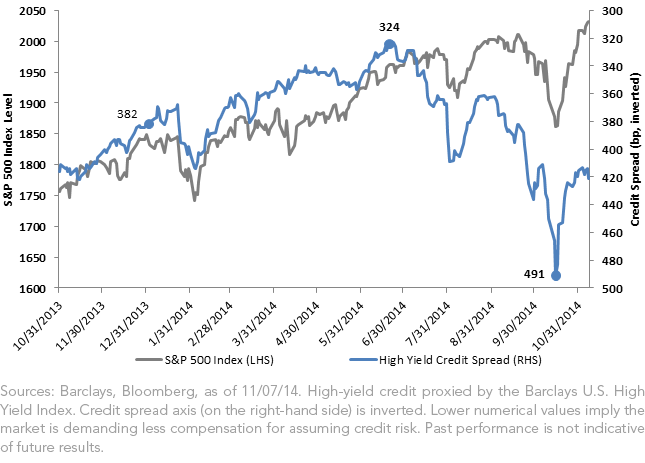Examining the Divergence between Equities and Credit


 For definitions of terms and indexes in the chart, please visit our glossary.
Default Rates vs. Flows
To understand which market is potentially under- or overvalued, it’s important to understand what might be driving this divergence. Historically, credit spreads and equities have generally exhibited a fairly consistent correlation, given that both benefit from positive economic momentum. With increasing corporate earnings, stock prices have risen. In an improving economy, risky borrowers generally pose a lower risk of risk of default due to strengthening fundamentals.2 Examining default risk more closely, over the last 12 months, Moody's reported that the average issuer default rate decreased to 1.7%. This compares to the 2.8% rate they reported at this time last year.3 With the economy continuing to perform, corporate fundamentals seem to be broadly supportive of strengthening credit conditions.
However, the price of credit is still ultimately dictated by supply and demand. While U.S. equities have seen strong inflows so far in 2014, high-yield bond strategies have seen net outflows of nearly $14 billion.4 Even though investors remain bullish on the U.S. economy, they are choosing to express this view via equities as opposed to fixed income. As a consequence, equity markets are outpacing the recovery in high-yield debt, resulting in a divergence.
Expressing a Bullish View of Credit
While we continue to believe that high yield can continue to perform well from a credit perspective, concerns about rising interest rates may be dampening investor enthusiasm and flows. In our view, an interesting alternative would be to own high-yield bonds but then hedge the interest rate risk of the portfolio. In this approach, investors are able to isolate their exposure to credit risk while reducing their exposure to movements in interest rates.
1Sources: WisdomTree, Bloomberg, as of 5/31/14.
2Figlewski, Stephen, Halina Frydman, Weijian Liang (2010), “Modeling the Effect of Macroeconomic Factors on Corporate Default and Credit Rating Transitions,” Credit Suisse.
3Source: Moody’s Investor Service, as of 10/31/14.
4Source: EPFR Global, as of 11/7/14.
For definitions of terms and indexes in the chart, please visit our glossary.
Default Rates vs. Flows
To understand which market is potentially under- or overvalued, it’s important to understand what might be driving this divergence. Historically, credit spreads and equities have generally exhibited a fairly consistent correlation, given that both benefit from positive economic momentum. With increasing corporate earnings, stock prices have risen. In an improving economy, risky borrowers generally pose a lower risk of risk of default due to strengthening fundamentals.2 Examining default risk more closely, over the last 12 months, Moody's reported that the average issuer default rate decreased to 1.7%. This compares to the 2.8% rate they reported at this time last year.3 With the economy continuing to perform, corporate fundamentals seem to be broadly supportive of strengthening credit conditions.
However, the price of credit is still ultimately dictated by supply and demand. While U.S. equities have seen strong inflows so far in 2014, high-yield bond strategies have seen net outflows of nearly $14 billion.4 Even though investors remain bullish on the U.S. economy, they are choosing to express this view via equities as opposed to fixed income. As a consequence, equity markets are outpacing the recovery in high-yield debt, resulting in a divergence.
Expressing a Bullish View of Credit
While we continue to believe that high yield can continue to perform well from a credit perspective, concerns about rising interest rates may be dampening investor enthusiasm and flows. In our view, an interesting alternative would be to own high-yield bonds but then hedge the interest rate risk of the portfolio. In this approach, investors are able to isolate their exposure to credit risk while reducing their exposure to movements in interest rates.
1Sources: WisdomTree, Bloomberg, as of 5/31/14.
2Figlewski, Stephen, Halina Frydman, Weijian Liang (2010), “Modeling the Effect of Macroeconomic Factors on Corporate Default and Credit Rating Transitions,” Credit Suisse.
3Source: Moody’s Investor Service, as of 10/31/14.
4Source: EPFR Global, as of 11/7/14.Important Risks Related to this Article
Fixed income investments are subject to interest rate risk; their value will normally decline as interest rates rise. In addition, when interest rates fall, income may decline. Fixed income investments are also subject to credit risk, the risk that the issuer of a bond will fail to pay interest and principal in a timely manner or that negative perceptions of the issuer’s ability to make such payments will cause the price of that bond to decline. There are risks associated with investing, including possible loss of principal. Non-investment-grade debt securities (also known as high-yield or “junk” bonds) have lower credit ratings and involve a greater risk to principal. The duration Funds seek to mitigate interest rate risk by taking short positions in U.S. Treasuries, but there is no guarantee this will be achieved. Derivative investments can be volatile, and these investments may be less liquid than other securities and more sensitive to the effects of varied economic conditions.


